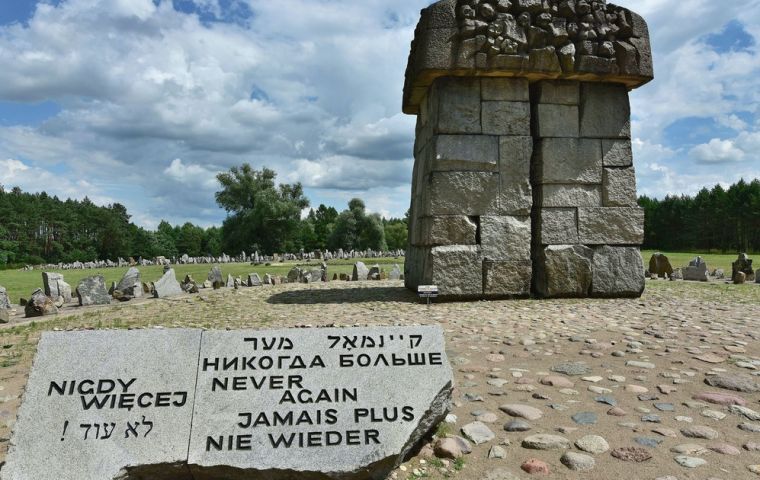MercoPress. South Atlantic News Agency
July 1942: Nazi Germany begins the systematic extermination of Polish Jews
 These train tracks led into the Treblinka extermination camp. The Nazis later tried to disguise their crimes
These train tracks led into the Treblinka extermination camp. The Nazis later tried to disguise their crimes In July 1942, Nazi Germany ordered the systematic extermination of the Jewish population in the Polish capital of Warsaw. Jews had been confined to the Warsaw Ghetto from November 1940, life was terrible. In the Ghetto to the northwest of the city some 450,000 men, women, and children lived crammed together behind the high walls. Around 100,000 people had died of hunger or disease, or been killed in summary executions. But the worse was to come on 22 July 1942.
Leaving the sealed-off district without permission was punishable by death, as was providing any kind of outside help to the inhabitants of the ghetto. The guards would even shoot little children who smuggled in food or coal. Emaciated corpses lying by the side of the road became part of daily life.
Almost a third of the population of the Polish capital was made up of Jews before World War II. They had been an integral party of the city on the Vistula for centuries. July 22, 1942, would mark a tragic turning point. On this day, Adam Czerniakow, an engineer and local politician, whom the Nazis had forced to become the head of the Warsaw Ghetto Jewish Council, wrote the following in his diary: “At 10 o'clock, Sturmbannführer Höfle appeared with his people. [ … ] We were told that all Jews, irrespective of sex and age — with certain exceptions — are to be deported to the East.” Every day, Czerniakow was to prepare 6,000 people from the ghetto for deportation. The SS later increased that daily target to 10,000.
On July 23, Czerniakow wrote a farewell letter to his wife: “They are demanding that I kill the children of my people with my own hands. There is nothing for me to do but to die.” He ended his life with a cyanide capsule — but his death did nothing to stop the extermination.
The Nazis carried out the deportations with the utmost brutality, in order to nip any attempt at resistance in the bud. Each house was surrounded; its occupants were whipped and beaten as they were driven out into the courtyard, then taken to the so-called “Umschlagplatz” (“collection point”) at the station.
People were taken to the Treblinka extermination camp in cattle trucks. After a long and miserable journey, they usually arrived only to be killed in the gas chambers that same day. The Germans disguised their operation, “Grossaktion” Warsaw, as “resettlement in the East,” but many soon realized that they were being sent to their deaths.
In early August, Janusz Korczak, a respected doctor, teacher and the director of an orphanage, arrived at the collection point along with the children in his care. He had had a chance to flee the ghetto, but had refused to abandon the children who had been entrusted to him. To allay their fears, he told them that they were going on a “trip to the countryside” — and went with them to the gas chamber, as did his colleague Stefania Wilczynska.
Adina Blady-Szwajgier, a pediatric nurse, chose a different path: She gave some of her young patients morphine, killing them before they could fall into the Nazis' hands.
Janusz Korczak, the head of the Jewish orphanage in Warsaw, chose to stay and die with the children in his care
According to German sources, more than 250,000 Jews were deported to Treblinka in just two months; Jewish sources say the number was closer to 300,000. Several thousand people who were too old or too sick to travel were taken to Warsaw's Jewish cemetery and shot.
Around 35,000 Jews were left alive, and sent to work in factories. Between 20,000 and 25,000 people escaped deportation, and continued to live “illegally” in what was left of the ghetto. In April 1943, those who remained were scheduled for deportation, which sparked the Warsaw Ghetto uprising, in which 13,000 Jews were killed. Those who remained were sent to Treblinka and other camps. As an eyewitness wrote at the time: “Jewish Warsaw has ceased to exist.”
The murder of the Warsaw Jews was, however, only part of the grand plan, code-named “Operation Reinhardt,” to exterminate all Jews in German-occupied Poland.
As early as October 13, 1941, Heinrich Himmler had instructed Odilo Globocnik, the head of the SS and police in the Lublin region, to murder the Jews in his area of control, the south of occupied Poland. Globocnik immediately started to construct the first of several extermination camps — Belzec. Later, two more were built — Sobibor and Treblinka — where victims were gassed immediately on arrival. From 1943 onward, Majdanek near Lublin also served as an extermination camp.
The killing continued until November 1943, when these camps were dismantled and disguised, and the last remaining prisoners shot. The Holocaust researcher Stephan Lehnstaedt estimates that the total number of victims of Operation Reinhardt was at least 1.8 million, perhaps as many as two million. The Nazi extermination of European Jews, which later became known as the Holocaust, continued until 1945. A total of six million people were killed, including hundreds of thousands of Sinti and Roma were also murdered.
The Soviets who had split Poland with Nazi Germany in 1939, also did their part trying to eliminate the Polish elite and leadership, killing some 22,000, some of whose remains were later found at the Katyn forest.




Top Comments
Disclaimer & comment rules-

Read all commentsYou can bet Gauchito Drink is celebrating with cheap “whiskey”...
Jul 25th, 2022 - 04:45 pm 0Commenting for this story is now closed.
If you have a Facebook account, become a fan and comment on our Facebook Page!